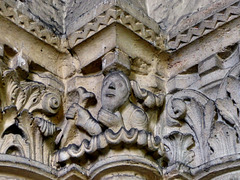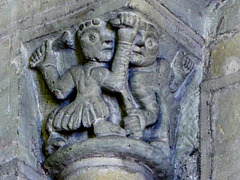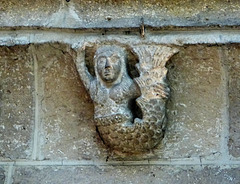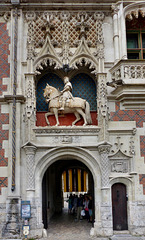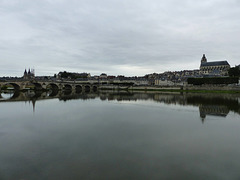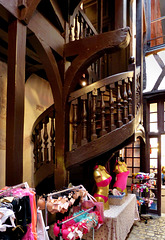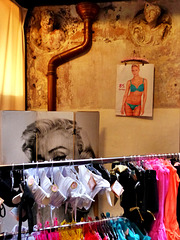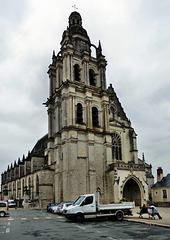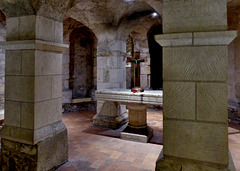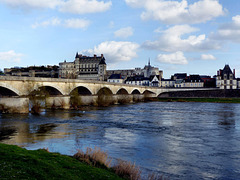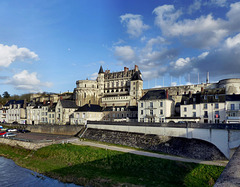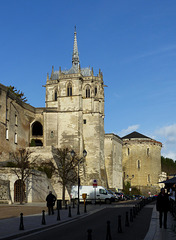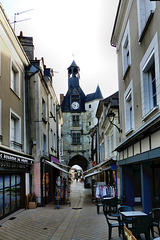
Centre
A collection of photos taken over the years. They just all have in common, that they were taken in "Centre" (since 2016 "Centre-Val de Loire") in France. Formed by the départements Cher (18), Eure-et-Loir (28)
Indre (36), Indre-et-Loire (37), Loir-et-Cher (41), Loiret (45).
Some were taken, when I crossed "Centre" following the "Via Lemovicensis" in 2006, or when I started the "Via Turonensis" i…
(read more)
Blois - Saint Nicholas
| |
|
|
Benedictine monks, escaping the Norman raids in the Normandie, settled here in 924 and founded the monastery. The large church was erected within the 12th and 13th century. As the monks had brought the valuable relics of Saint Laumer, Saint Lubin, Saint Mary of Egypt and a fragment of the True Cross this was a place of medieval pilgrimage.
The church was dedicated to Saint Laumer, the convent existed up to the French Revolution. Since then it serves the parish, dedicated now to Saint Nicholas, remembering a nearby church, that got demolished after the Revolution.
Some really experienced masters carved the capitals near the crossing. Here a gentleman pulls his beard, contemplating about a complex problem. Or is he a dreaming star gazer.
Blois - Saint Nicholas
| |
|
|
Benedictine monks, escaping the Norman raids in the Normandie, settled here in 924 and founded the monastery. The large church was erected within the 12th and 13th century. As the monks had brought the valuable relics of Saint Laumer, Saint Lubin, Saint Mary of Egypt and a fragment of the True Cross this was a place of medieval pilgrimage.
The church was dedicated to Saint Laumer, the convent existed up to the French Revolution. Since then it serves the parish, dedicated now to Saint Nicholas, remembering a nearby church, that got demolished after the Revolution.
Not all the carvings here are that sophisticated as that one on the previous upload. Neither from the style, not for the theme. Here is a rough carving depicting a pub brawl. As both drunkards hold knives, this fight may end in tragedy.
Blois - Saint Nicholas
| |
|
Benedictine monks, escaping the Norman raids in the Normandie, settled here in 924 and founded the monastery. The large church was erected within the 12th and 13th century. As the monks had brought the valuable relics of Saint Laumer, Saint Lubin, Saint Mary of Egypt and a fragment of the True Cross this was a place of medieval pilgrimage.
The church was dedicated to Saint Laumer, the convent existed up to the French Revolution. Since then it serves the parish, dedicated now to Saint Nicholas, remembering a nearby church, that got demolished after the Revolution.
This small mermaid lives under Saint Nicholas´ roof.
Blois - Château
| |
|
|
|
Charles of Orléans, the medieval poet, lived here. He had inherited the château from his mother Valentina Visconti, widow of Louis de Valois, the brother of King Charles VI of France.
In 1407 Louis had been assassinated on order of (his cousin) John the Fearless, Duke of Burgundy. John the Fearless then was stabbed in 1419 by Tanneguy du Chastel. I had just found the grave of Tanneguy´s son some days ago in Cléry-Saint-André. Everything is connected..
Charles of Orléans, the poet, tried to revenge his father´s assasination. In 1415 he was taken prisoner at the Battle of Agincourt and spent 25 (twenty-five!) years as a hostage in England, before returning to Blois.
This château became the favourite royal residence and the political capital of the kingdom under Charles' son, King Louis XII.
Note the crowned porcupines (a large over the small door, a smaller one over the arch of the large). The porcupine stands as a symbol of King Louis XII.
www.chateaudeblois.fr/?lang=en
Blois - Loire
| |
|
|
I could not continue my walk with due to the broken toe. So I spent some days in Blois, hoping for a miracle or at least a significant improvement.
Seen here is the Loire crossed by the Pont Jacques-Gabriel. Saint Nicholas on the left, the château in the center and the cathedral on the right.
Blois - Lingerie
| |
|
|
Blois was a really wealthy city during time of the Renaissance.
Many wonderful, often half-timbered buildings in the inner city date back to this time. The ground floor of this one, including the former patio from which a wooden spiral stair leads up, is now used as a lingerie-shop. I could not find out, what is upstairs.
Blois - Lingerie
| |
|
Blois was a really wealthy city during time of the Renaissance.
Many wonderful buildings in the inner city date back to this time. This one is now used as a lingerie-shop.
The two gentlemen in the medallions on the wall have seen a lot over the last centuries. Now they keep an eye on the lingerie below and so discourage potential shoplifters.
Blois - Cathédrale Saint-Louis
| |
|
|
A chapel, dedicated to Saint Peter, was here already during Merovingian times. In the 12th century a large church, dedicated to Saint Solenne, had replaced the chapel. Of this Romanesque church only the large crypt still exists.
The façade and the belltower, seen here, were built in 1544. The nave was destroyed by a hurricane in 1678.
The reconstruction took place between 1680 and 1700, and as Louis XIV of France sponsored the organ loft in 1704, the cathedral now is dedicated to Saint Louis.
Blois - Cathédrale Saint-Louis
| |
|
|
A small stair leads down to a large crypt, that was discovered in 1927. It was part of a 10th century Carolingian church, that was followed by a Romanesque one about 200 years later. The church was dedicated to Saint Solenne, bishop of Chartres within the 5th century, whose relics were venerated here.
Blois - Cathédrale Saint-Louis
| |
|
A small stair leads down to a large crypt, that was discovered in 1927. It was part of a 10th century Carolingian church, that was followed by a Romanesque one about 200 years later. The church was dedicated to Saint Solenne, bishop of Chartres within the 5th century, whose relics were venerated here.
Chaumont-sur-Loire
| |
|
|
I had stayed overnight in a nice "chambre d ́hotes" in Onzain on the right side of the Loire. A bridge spans over the Loire here. The Via Turonensis runs through Chaumont sur Loire and turns "inland" just after the castle.
The Château de Chaumont was once owned by Catherine de Medici, who entertained here numerous astrologers, among them Nostradamus. Later she forced her husband´s mistress Diane de Poitiers, to exchange Château de Chaumont for Château de Chenonceau.
Chaumont-sur-Loire
| |
|
|
|
A castle existed here since the 10th century, but when Pierre d'Amboise unsuccessfully rebelled against Louis XI the castle was dismantled on royal order in 1465. It got rebuilt and acquired by Catherine de Medici.
After the death of Henry II, she forced his mistress Diane de Poitiers, to exchange Château de Chaumont for Château de Chenonceau. It changed hands quite often. In 1810 Madame de Staël, exiled from Paris by Napoleon, finished "De l'Allemagne" here.
The Château de Chaumont meanwhile hosts a museum
www.domaine-chaumont.fr/en_general_accueil
Amboise - Château
| |
|
|
|
The "Château d'Amboise rises over the town.
It´s owner Louis d'Amboise had unsucessfully plotted against Louis XI and was condemned to be executed in 1431. King Charles VII (aka "le Bien-Servi") pardoned him but took his château at Amboise.
For about two centuries the château was a favourite of French kings. Over many decades the château got rebuilt. First in flamboyant Gothic later under Italian architects in Renaissance style.
It was here, where Charles VIII died in 1498, afte after he hit his head on a door lintel. Francis I was raised here. He later invited Leonardo da Vinci to Amboise. Leonardo arrived in 1515 and lived here upto his death in 1519.
Henry II and Catherine de Medici raised their children here along with Mary Stuart, the child Queen of Scotland who had been promised in marriage to the future French Francis II.
www.chateau-amboise.com/en/
Amboise - Château
| |
|
|
|
The "Château d'Amboise rises over the town.
It´s owner Louis d'Amboise had unsucessfully plotted against Louis XI and was condemned to be executed in 1431. King Charles VII (aka "le Bien-Servi") pardoned him but took his château at Amboise.
For about two centuries the château was a favourite of French kings. Over many decades the château got rebuilt. First in flamboyant Gothic later under Italian architects in Renaissance style.
It was here, where Charles VIII died in 1498, afte after he hit his head on a door lintel. Francis I was raised here. He later invited Leonardo da Vinci to Amboise. Leonardo arrived in 1515 and lived here upto his death in 1519.
Henry II and Catherine de Medici raised their children here along with Mary Stuart, the child Queen of Scotland who had been promised in marriage to the future French Francis II.
www.chateau-amboise.com/en/
Amboise - Château
| |
|
|
|
The "Château d'Amboise rises over the town.
It´s owner Louis d'Amboise had unsucessfully plotted against Louis XI and was condemned to be executed in 1431. King Charles VII (aka "le Bien-Servi") pardoned him but took his château at Amboise.
For about two centuries the château was a favourite of French kings. Over many decades the château got rebuilt. First in flamboyant Gothic later under Italian architects in Renaissance style.
It was here, where Charles VIII died in 1498, afte after he hit his head on a door lintel. Francis I was raised here. He later invited Leonardo da Vinci to Amboise. Leonardo arrived in 1515 and lived here upto his death in 1519.
Following his last will, Leonardo got buried on the graveyard of Saint Florentin, a collegiate, in Amboise. In 1874 the bones got transferred to the Saint-Hubert chapel, part of the château, so the tomb now is in the chapel seen here.
www.chateau-amboise.com/en/
Amboise - La Tour de l'Horloge
| |
|
|
The "Tour de l'Horloge" once was a city gate ("Porte de l’Amasse") and part of the fortification. The pilgrims following the Via Turonensis entered Amboise here
Amboise - St. Denis
| |
|
|
|
Late afternoon in Amboise - the doors opf St. Denis are still open.
The construction of this church was started about 1107 by Hugues, the first Lord of Amboise. It replaced an ancient church, probably from the 4th century, dedicated to St. Martin of Tours. The Romanesque church was part of a Benedictine priory, depending from the abbey Saint-Julien de Tours but as well served the parish. The structure got modified and enlarged in the 16th century.
Amboise - St. Denis
| |
|
The construction of this church was started about 1107 by Hugues, the first Lord of Amboise. It replaced an ancient church, probably from the 4th century, dedicated to St. Martin of Tours. The Romanesque church was part of a Benedictine priory, depending from the abbey Saint-Julien de Tours but as well served the parish. The structure got modified and enlarged in the 16th century.
Strange scenes are on (13thc.?) capitals inside the church.
A "Master of Beasts" performing with two-headed, winged(?) snakes? Surely creatures of hell just like animals standing upright. The devil shows a well dressed sinner, while a lady with long braids does a perfect handstand.
Jump to top
RSS feed- Latest items - Subscribe to the latest items added to this album
- ipernity © 2007-2024
- Help & Contact
|
Club news
|
About ipernity
|
History |
ipernity Club & Prices |
Guide of good conduct
Donate | Group guidelines | Privacy policy | Terms of use | Statutes | In memoria -
Facebook
Twitter

